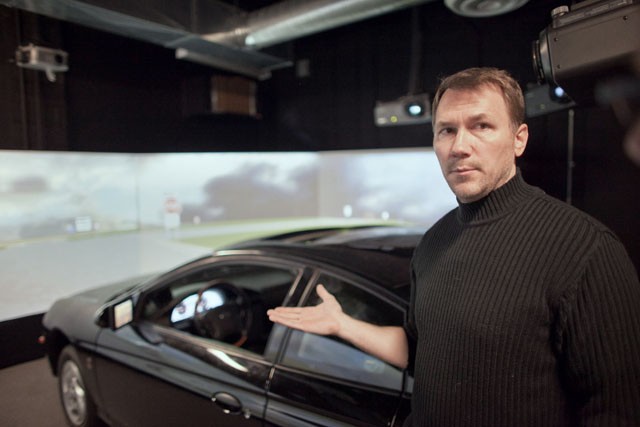Driving on congested metropolitan highways can be stressful.
But imagine driving a 12-ton city bus down a narrow shoulder thatâÄôs covered in ice and snow. TrafficâÄôs driving past, leaving little room for error.
ThatâÄôs what many city buses have been doing on the metro areaâÄôs 257-plus miles of bus-only shoulder lanes.
Researchers at the University of MinnesotaâÄôs Intelligent Transportations Systems Institute have developed technology that aids drivers and reduces their stress, which hopefully will cut down on accidents.
Ten Minnesota Valley Transit Authority buses have been using the Driver Assist Systems since last summer.
With shoulders only one foot wider than the bus, driving on the shoulder leaves little room for error âÄî especially if the driver canâÄôt see where the shoulder ends.
DAS uses GPS-mapping to determine where the shoulder lanes are and automatically turns on the system once the driver moves onto the shoulder. A heads-up display shows where the shoulder lanes are, another screen shows vehicles in the driverâÄôs blind spot and the wheel shakes when the driver gets too close to either side of the shoulder.
The $5 million project was mostly funded by a federal grant to the State of Minnesota in 2007 as part of the Urban Partnership Agreement, which rewarded cities that created programs to combat traffic congestion. The MVTA and the University are partners on the project.
The MVTA has an in-house simulator resembling the front of a bus to help train drivers to use the system.
Michael Manser is director of the HumanFIRST Program, which studies human interaction with new technologies like the assistance system.
When someone takes an exam they can get worked up and make stupid mistakes, Manser said.
“The same thing happens when people drive cars âĦ They get in a high-stress situation. They start to ignore important cues in the environment, they start to make mistakes and thatâÄôs kind of what weâÄôre trying to prevent.”
The technology has been used in snowplows in Alaska, where road lanes can be virtually invisible. Two snowplows using the technology clear the Thompson Pass in Alaska, an area thatâÄôs known for its heavy snowfall.
Bryan Newstrom, lead developer of DAS, said that while some drivers, like more experienced snowplow operators, may be resistant to the technology, others are more willing to adapt.
“Some of the old, crusty guys who have been there for a long time say that they know how to plow snow,” Newstrom said. “The younger guys coming in who have played video games are used to that technology.”
Manser added that his lab sent out about three dozen surveys to drivers who have used the technology and received mostly-positive feedback.
Researchers at the University of California-Berkley focused on a similar goal but used magnets embedded in the street to help guide buses.
Louis Sanders, director of technical services for the American Public Transportation Association, said he prefers the GPS model because it can be applied in any environment.
But before the technology can be expanded past the 10 buses in Minnesota, it has to prove itâÄôs worth the $5 million price tag.
“The government is âÄî as we are âÄî very interested in seeing [this technology] deployed,” Sanders said. “It has to demonstrate utility.”








